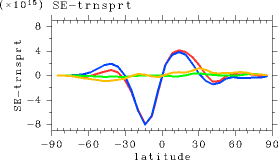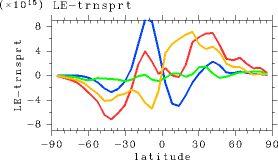E. Atmospheric Structure in Equilibrium States |
Meridional Energy Transport in Experiment S1570
In experiment S1570, latent heat transport remarkably increases (Figure 1). The distribution of dry static energy transport shows that the component of mean meridional circulation is dominant near 45 latitude north and south. The reason is considered to be that the contribution of transient disturbances decreases since meridional temperature difference in mid- and high-latitude region decreases (Figure is not shown). Further study on structure of disturbances is necessary to answer this problem.
The distribution of latent heat energy transport shows that total amount of transport relatively decreases in equatorial region. The equatorward transport by mean meridional circulation is canceled out by poleward transport by transient disturbances. As a result, the evaporation is balanced with precipitation in equatorial region and it seems that the equatorial region is a closed system. As is the case in experiment S1380, the transient disturbance component is dominant near 40 latitude north and south where the latent heat transport is maximum: the transient disturbances near 40 latitude north and south are vortex disturbances emerging in equatorial region and migrating to mid-latitude region which are accompanied with precipitation (See Characteristics of Atmospheric Disturbance in Equilibrium State).
(a) 
(b) 
Figure 1:
Meridional energy transport in experiment S1570 (W). (a): Meridional dry static energy transport. (b): Meridional latent heat energy transport. Red: total transport. Blue: transport by the mean meridional circulation. Green: transport by stationary disturbances. Light brown: transport by transient disturbances.